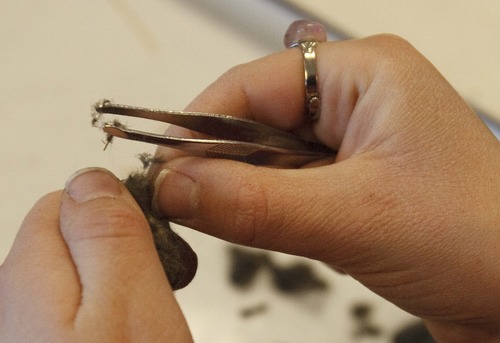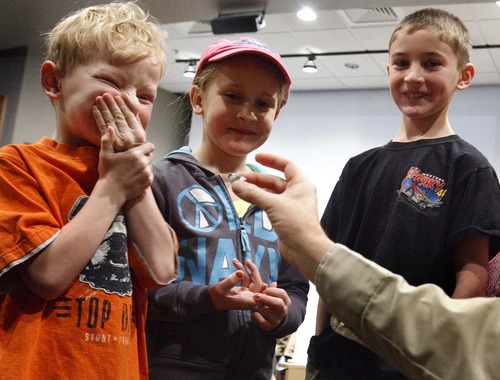This is an archived article that was published on sltrib.com in 2013, and information in the article may be outdated. It is provided only for personal research purposes and may not be reprinted.
Brigham City • A lone parent remains fixated on a pile of owl feces as she holds her tweezers to find miniature bones in one pile while discarding the dusty fur of rodents in another. Her children have already left the room and moved on to other things.
"I didn't want to do it," said West Valley resident Carrie Martin, who decided to dissect the owl pellet under duress from her children. "It's disgusting and it's gross and it feels horrible, but it's kind of cool. So I love it."
On Saturday morning, residents from around the Wasatch Front watched a live short-eared owl, took part in crafts and face painting and even probed owl pellets during Owl Day at the Bear River Migratory Bird Refuge.
Owl Day is one of many events the refuge makes available to the public at no cost. The U.S. Fish and Wildlife Service schedules events on the second Saturday of each month, but the Wildlife Education Center is open six days a week. There is also a 12-mile loop drive where people can view birds from the road on the refuges.
"We are here to broaden their horizons," said refuge wildlife specialist Katie McVey. "All these kids with owls painted on their faces? They are our future. If they don't learn to care about wildlife that is a problem."
McVey said owls typically hoot to communicate with family but also call to ward off others in their territory. The largest and most common owl in urban areas is the Great Horned Owl. It feeds on rodents, skunks and sometimes small birds.
Great Horned Owls can nest in urban areas, picking spots like the overhang of a high-rise roof. It's easiest to hear them hooting during breeding season, which is from now until February, and they are most visible in April and May when new babies hatch. Only 1 in 10 survives the first year of life, McVey said, but owls that do can live up to 20 years.
In 1928, the 80,000-acre refuge was created to provide "protection for wild animals," McVey said. It also serves as a place for the public to learn to appreciate wildlife and the outdoors, she said.
Ogden Nature Center employees brought a short-eared owl for children to see and invited visitors to join a "hoot" calling competition. The Nature Center often collaborates with the bird refuge to bring live animals to events.
A self-proclaimed "owl nut," Nadia Fontecchio, 13, of Lewiston, said she has been crazy about owls since she did a presentation about them in fifth grade. When she saw the ad for the Owl Day, she said, "Oh my gosh, I have to go."
Even her brother, who makes fun of her affinity for owls, enjoyed himself, she said, wearing a shirt with an owl silhouette. "It's been an amazing experience."
Coming up, the center plans Bald Eagle Day on Feb. 9 and Swan Day on March 9. For more information, find them on Facebook or Twitter or visit http://www.fws.gov/refuge/bear_river_migratory_bird_refuge .













